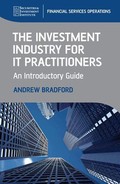Contents
Part One: Investments and Securities Explained
Chapter 1: An Introduction to Financial Instruments
2.1 Listed and Unlisted Equities
2.3 The Issuance of Listed Equities – The Primary Market
2.4 The Secondary Market in Equities
3.2 Accrued Interest on Bonds in the Secondary Market
3.4 How Prices are Formed in the Secondary Market
4.1 Cash as A Means of Exchange
4.2 Cash as An Investment Class
5.1 Exchange Traded Derivative Contracts
Chapter 6: Common Attributes of Financial Instruments
6.1 Summary of All Trade Terminology Used in Chapters 1 to 5
6.2 Summary of Basic Trade Arithmetic for Transactions in Securities, Futures and Options
Chapter 7: Market Participants
7.3 Institutional Fund Managers
7.4 Private Client Stockbrokers and Investment Managers
7.5 Investment Banks that Accept and Execute Orders from Investors
Chapter 8: How Investment Firms are Regulated
8.5 The UK Perspective – The Role of the Financial Services Authority
8.6 Specific Offences in the United Kingdom
8.7 Regulation and Its Impact on the IT Function
Chapter 9: Straight-Through-Processing
9.2 To What Extent is STP Actually Achieved in Practice?
Chapter 10: The Role of Accurate Static Data in the STP Process
10.2 Duplication of Static Data Across Systems
10.3 Instrument Group Static Data
10.5 Trading Party and Settlement Agent Static Data
10.6 Standard Settlement Instructions (SSIs)
10.7 Static Data that is Internal to the Firm Concerned
10.8 Normal Working Days and Public Holidays
Chapter 11: Communications Between Industry Participants
11.2 The Financial Information Exchange (Fix Protocol)
Chapter 12: The Trade Agreement and Settlement Processes
12.1 The Trade Agreement Process
12.2 Communications Between the Trade Party and Its Settlement Agent
Chapter 13: Failed Trades – Causes, Consequences and Resolution
13.2 Consequences of Failed Trades
13.3 The Prevention and Resolution of Failed Trades and the Impact on it Applications
Chapter 14: An Overview of Investment Accounting
14.1 Role of the Financial Control Department
16.2 Equity Agency Trades with Institutional Investor Customers
16.3 Equity Agency Trades with Private Investor Customers
Chapter 17: The STP Flow of Debt Instrument Trades
17.6 Regulatory Trade Reporting
17.8 General Ledger Postings for the Trade and the Settlement
17.9 Stock Record Postings for the Trade and the Settlement
Chapter 18: The STP Flow of Foreign Exchange and Money Market Trades
Chapter 19: The STP Flow of Futures and Options Transactions
19.2 Futures and Options – Common Process Steps
19.3 Futures-Specific Process Steps
19.4 Options-Specific Process Steps
Chapter 20: The STP Flow of Swap and other OTC Drivative Trades
20.4 Trade Components and Amounts
20.6 Regulatory Trade Reporting
20.11 Daily Accrual of Interest
Chapter 21: Stock Lending, Repos and Funding
21.2 Stock Lending and Borrowing Transactions
21.4 Summary of the Differences Between the Various Transaction Types
21.5 The Role of Specialist Lending Intermediaries (SLIs)
21.6 Business Applications to Support Stock Lending and Repos
Chapter 22: The Impact of Islamic Finance
22.2 Delivering Islamic Financial Services
22.3 Sharia Compliant Instruments
22.4 The Valuation and Risk Management of Islamic Financing Instruments
22.5 The IT Implications of Providing Islamic Instruments
Chapter 23: The Management of Positions
23.2 Trade Dated, Value Dated, Settled and Depot Positions
23.3 Interest Payments and Interest Rate Fixings
23.4 Collection of Maturity Proceeds
23.7 Listed Derivatives – Contract Expiry and Delivery Dates
23.8 Marking Positions to Market
Chapter 24: The Management of Risk
24.4 The Role of the Board of Directors in Managing Risk
24.5 The Role of the Risk Management Department
24.6 An Introduction to Value-At-Risk (VaR)
Part Two: Good IT Practice in the Investment Industry
Chapter 25: The Role of the IT Department in Daily Operations
25.2 User Support and Helpdesk Management
25.3 Data Security, Data Retention, Data Protection and Intellectual Property
25.5 Business Continuity Planning
25.6 Use of the IT Infrastructure Library in Managing it Operations
Chapter 26: The Role of the IT Department in Managing Business Change
26.2 The Software Development Lifecycle
26.3 Project Management Standards
26.4 Software Development Models
26.6 Quality Assurance Testing
Chapter 27: Package and Vendor Selection, Outsourcing and Offshoring
27.1 Making the Buy or Build Decision
27.2 Vendor and Package Selection
27.3 Outsourcing and Offshoring
Appendix 1: Bond Market Price Calculations
Valuation Methodologies for Other Types of Debt Instrument
